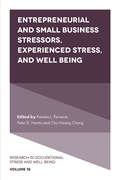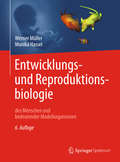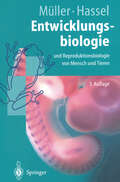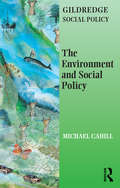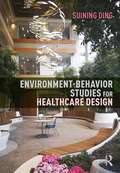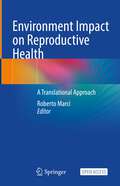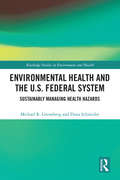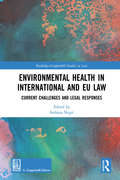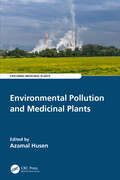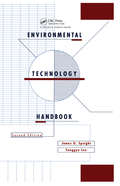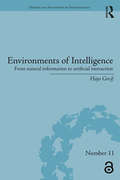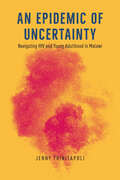- Table View
- List View
Entertaining Satan: Witchcraft and the Culture of Early New England
by John Putnam DemosIn the first edition of the Bancroft Prize-winning Entertaining Satan, John Putnam Demos presented an entirely new perspective on American witchcraft. By investigating the surviving historical documents of over a hundred actual witchcraft cases, he vividly recreated the world of New England during the witchcraft trials and brought to light fascinating information on the role of witchcraft in early American culture. Now Demos has revisited his original work and updated it to illustrate why these early Americans' strange views on witchcraft still matter to us today. He provides a new preface that puts forth a broader overview of witchcraft and looks at its place around the world--from ancient times right up to the present.
Entertaining Satan: Witchcraft and the Culture of Early New England
by John Putnam DemosIn the first edition of the Bancroft Prize-winning Entertaining Satan, John Putnam Demos presented an entirely new perspective on American witchcraft. By investigating the surviving historical documents of over a hundred actual witchcraft cases, he vividly recreated the world of New England during the witchcraft trials and brought to light fascinating information on the role of witchcraft in early American culture. Now Demos has revisited his original work and updated it to illustrate why these early Americans' strange views on witchcraft still matter to us today. He provides a new preface that puts forth a broader overview of witchcraft and looks at its place around the world--from ancient times right up to the present.
Entrepreneurial and Small Business Stressors, Experienced Stress, and Well Being (Research in Occupational Stress and Well Being #18)
by Pamela L. Perrewé, Peter D. Harms, Chu-Hsiang ChangVolume 18 of Research in Occupational Stress and Well-Being is focused on the stress and well-being related to Entrepreneurship and Small Businesses. This volume focuses on entrepreneurial and small business owners; stress, health, and well-being as it relates to personal, work, and success outcomes. The literature linking stress with entrepreneurship and small business has been somewhat scattered to date in that stress has been treated as an antecedent of decisions to create new ventures, a frequent outcome experienced by entrepreneurs and small business owners (or self-employed businesses), and a moderator of the entrepreneurial process. We attempt to resolve some of the inconsistences theoretically and to better frame future research in this important area of study. We have seven chapters that cover topics from theory-building to context in small businesses to utilizing resources. We have divided our seven chapters into three sections. In the first section, we include three chapters that examine new theories, frameworks and future research agendas in entrepreneurship. In the second section, we have two chapters that examine contexts, specifically, heterogeneity and non-family membership in small businesses. In the final section, we have chapters that examine the important role of resources in entrepreneurship. We believe this volume offers critical analyses of research on stress and entrepreneurship as well new frameworks for future research.
Entrepreneurial and Small Business Stressors, Experienced Stress, and Well Being (Research in Occupational Stress and Well Being #18)
by Pamela L. Perrewé Peter D. Harms Chu-Hsiang Daisy ChangVolume 18 of Research in Occupational Stress and Well-Being is focused on the stress and well-being related to Entrepreneurship and Small Businesses. This volume focuses on entrepreneurial and small business owners; stress, health, and well-being as it relates to personal, work, and success outcomes. The literature linking stress with entrepreneurship and small business has been somewhat scattered to date in that stress has been treated as an antecedent of decisions to create new ventures, a frequent outcome experienced by entrepreneurs and small business owners (or self-employed businesses), and a moderator of the entrepreneurial process. We attempt to resolve some of the inconsistences theoretically and to better frame future research in this important area of study. We have seven chapters that cover topics from theory-building to context in small businesses to utilizing resources. We have divided our seven chapters into three sections. In the first section, we include three chapters that examine new theories, frameworks and future research agendas in entrepreneurship. In the second section, we have two chapters that examine contexts, specifically, heterogeneity and non-family membership in small businesses. In the final section, we have chapters that examine the important role of resources in entrepreneurship. We believe this volume offers critical analyses of research on stress and entrepreneurship as well new frameworks for future research.
Entspannen durch Meditation für Dummies Das Pocketbuch (Für Dummies)
by Stephan BodianGelöst und zufrieden wie ein Buddha ganz in sich selbst versinken - wenn Sie davon schon einmal geträumt haben, dann ist Meditation genau das Richtige für Sie. Erfahren Sie, wie Sie Ihre Aufmerksamkeit nach innen richten und Ihren Geist trainieren, welche die beste Sitzhaltung ist und wie Sie sich mit Yoga-Übungen auf das Sitzen vorbereiten können. Der Autor zeigt Ihnen zudem, wann, wie und wo Sie am besten meditieren und wie Sie die Meditation auch im Alltag einsetzen können. Lassen Sie sich von dem langjährigen Meditationslehrer Stephan Bodian in die Geheimnisse der Meditation einweihen und genießen Sie es!
Entwicklungsbiologie: und Reproduktionsbiologie von Mensch und Tieren (Springer-Lehrbuch)
by Werner A. Müller Monika HasselDas Lehrbuch bietet einen Überblick über die Entwicklung der bedeutendsten Modellorganismen und die Embryonalentwicklung des Menschen. Im Vordergrund stehen allgemeine Prinzipien und Grundmuster. Hinzu kommen vergleichende Ausführungen zu Aspekten der Evolution, Entwicklungsgenetik und Sexualentwicklung. Daneben werden aktuelle Forschungsfragen behandelt, u. a. zum Evolution Development und dem Einfluss von Umweltsubstanzen auf die Sexualentwicklung. Die 4. Auflage enthält eine Reihe neuer Abbildungen sowie Tafeln mit vierfarbigen Darstellungen.
Entwicklungsbiologie und Reproduktionsbiologie des Menschen und bedeutender Modellorganismen (Springer-Lehrbuch)
by Werner A. Müller Monika HasselDie faszinierende Entwicklung von Ei und Spermium zum komplexen Organismus ist das Thema des Lehrbuchs. Die Autoren liefern einen Überblick über die Entwicklung wichtiger Modellorganismen und die Embryonalentwicklung des Menschen. Dabei berücksichtigen sie aktuelle Forschungsfragen wie u. a. Klonen, transgene Tiere und Gentherapie. In der 5. Auflage sind alle Abbildungen 4-farbig, die Themen „Entwicklung des Menschen“ und „Evolution von Entwicklungsprozessen“ werden ausführlicher dargestellt. Mit umfangreichem Glossar und Literaturverzeichnis.
Entwicklungsbiologie und Reproduktionsbiologie des Menschen und bedeutender Modellorganismen (Springer-Lehrbuch)
by Werner A. Müller Monika HasselDie faszinierende Entwicklung von Ei und Spermium zum komplexen Organismus ist das Thema des Lehrbuchs. Die Autoren liefern einen Überblick über die Entwicklung wichtiger Modellorganismen und die Embryonalentwicklung des Menschen. Dabei berücksichtigen sie aktuelle Forschungsfragen wie u. a. Klonen, transgene Tiere und Gentherapie. In der 5. Auflage sind alle Abbildungen 4-farbig, die Themen „Entwicklung des Menschen“ und „Evolution von Entwicklungsprozessen“ werden ausführlicher dargestellt. Mit umfangreichem Glossar und Literaturverzeichnis.
Entwicklungsbiologie und Reproduktionsbiologie von Mensch und Tieren: Ein einführendes Lehrbuch (Springer-Lehrbuch)
by Werner A. Müller Monika HasselKlonen von Tieren und Menschen ist derzeit das am häufigsten genannte und am heftigsten umstrittene Thema der Entwicklungsbiologie, über das Tagespresse und Medien berichten. Ein anderes Thema ist die Erzeugung "transgener" Tiere, in die artfremde, darunter gar menschliche Gene einge baut werden, und möglicherweise gehört zu diesen Themen auch bald die gezielte Steuerung des Geschlechts. Eng mit der Entwicklungsbiologie ver woben sind aber auch die Krebsforschung und die Gentherapie von Erb krankheiten. Diese beispielhaft herausgegriffenen Themen zeigen schon: Entwicklungsbiologie ist ein hochaktuelles Gebiet der Biologie und auch für die Medizin von Belang. Die Entwicklungsbiologie zählt in der Tat zu jenen Sparten der Biowis senschaften, die derzeit eine explosive Entfaltung erfahren. Treibende Kraft ist das Bestreben der Genetiker und Molekularbiologen, das Wirken von Genen zu verstehen und Verfahren zu finden, um selbst Genaktivitäten steuern zu können. Treibende Kraft ist auch das Bestreben der Mediziner, helfend in das Reproduktionsgeschehen einzugreifen und Fehlleistungen wie die Entwicklung von Krebs zu verstehen. Größte treibende Kraft ist je doch die Wissbegierde des Menschen, der eines der größten Geheimnisse der Natur enträtseln möchte: die Entwicklung eines komplexen Organis mus mit seiner erstaunlichen körperlichen und geistigen Leistungsfähigkeit aus der vergleichsweise wenig strukturierten Materie einer befruchteten Ei zelle.
The Environment and Social Policy (The Gildredge Social Policy Series)
by Michael CahillFocusing on human welfare and the environment from a social policy perspective, this text shows how environmental concerns are becoming increasingly central to policy-making and discusses the roles of central and local government in relation to environmental issues.The Environment and Social Policy covers the following contemporary topics: sustainability, Local Agenda 21, green ideas, environmental health, housing and urban development, food, work, globalisation. Each chapter starts with an overview of the topics and ends with a list of key points and a guide to further reading. Core concepts are clearly explained and illustrated throughout this text which provides students with a concise and up-to-date summary of what they need to know.
The Environment and Social Policy (The Gildredge Social Policy Series)
by Michael CahillFocusing on human welfare and the environment from a social policy perspective, this text shows how environmental concerns are becoming increasingly central to policy-making and discusses the roles of central and local government in relation to environmental issues.The Environment and Social Policy covers the following contemporary topics: sustainability, Local Agenda 21, green ideas, environmental health, housing and urban development, food, work, globalisation. Each chapter starts with an overview of the topics and ends with a list of key points and a guide to further reading. Core concepts are clearly explained and illustrated throughout this text which provides students with a concise and up-to-date summary of what they need to know.
Environment-Behavior Studies for Healthcare Design
by Suining DingEnvironment-Behavior Studies for Healthcare Design explains how environment-behavior (EB) studies can contribute to healthcare design research and explores how evidence-based theories can be applied and integrated into the healthcare design practice. Drawing on EB theories and the latest research in environment-behavior studies, this book shows how the healthcare environment can positively impact patients' and caregivers' well-being and healthcare organization's efficiency by modifying environmental attributes, such as space configuration, color, lighting, signage, acoustics, and artwork. It addresses a range of healthcare facilities including children's hospitals, long-term care, acute care and outpatient care facilities, and uses a range of evidence-based design research methods, such as interviews, focus groups, observations, surveys and space syntax. The author also explains how research evidence and evidence-based design can be integrated into healthcare design more cohesively in a redefined design process. This book provides a solid conceptual structure that informs a clear map for understanding the EB theories and their applications in healthcare design. This research guide for healthcare design helps students, academics, designers and architects reconsider how to create environments that support patients’ healing and well-being whilst considering efficiency and safety.
Environment-Behavior Studies for Healthcare Design
by Suining DingEnvironment-Behavior Studies for Healthcare Design explains how environment-behavior (EB) studies can contribute to healthcare design research and explores how evidence-based theories can be applied and integrated into the healthcare design practice. Drawing on EB theories and the latest research in environment-behavior studies, this book shows how the healthcare environment can positively impact patients' and caregivers' well-being and healthcare organization's efficiency by modifying environmental attributes, such as space configuration, color, lighting, signage, acoustics, and artwork. It addresses a range of healthcare facilities including children's hospitals, long-term care, acute care and outpatient care facilities, and uses a range of evidence-based design research methods, such as interviews, focus groups, observations, surveys and space syntax. The author also explains how research evidence and evidence-based design can be integrated into healthcare design more cohesively in a redefined design process. This book provides a solid conceptual structure that informs a clear map for understanding the EB theories and their applications in healthcare design. This research guide for healthcare design helps students, academics, designers and architects reconsider how to create environments that support patients’ healing and well-being whilst considering efficiency and safety.
Environment Impact on Reproductive Health: A Translational Approach
by Roberto MarciThis open access book focuses on of the impact of endocrine disrupting chemicals (EDCs) on human reproduction. It comprehensively discusses the three most important topics in the field: the basic biology of EDCs; the effects of EDCs on human reproduction and human reproductive systems; and potential interventions and practical advice for dealing with the problems caused by EDCs.Presenting a translational approach to endocrine disrupting chemicals research, spanning both basic biology and clinical applications, the book provides a critical link between laboratory investigations and clinical practice. Written by international experts in the field, it is a valuable reference resource for gynaecologists, obstetricians, endocrinologists and experts in reproductive medicine, and a useful tool for anyone interested in the impact of the environment on human reproduction.
Environmental Health and the U.S. Federal System: Sustainably Managing Health Hazards (Routledge Studies in Environment and Health)
by Michael R Greenberg Dona SchneiderThis book explains how the U.S. federal system manages environmental health issues, with a unique focus on risk management and human health outcomes. Building on a generic approach for understanding human health risk, this book shows how federalism has evolved in response to environmental health problems, political and ideological variations in Washington D.C, as well as in-state and local governments. It examines laws, rules and regulations, showing how they stretch or fail to adapt to environmental health challenges. Emphasis is placed on human health and safety risk and how decisions have been influenced by environmental health information. The authors review different forms of federalism, and analyse how it has had to adapt to ever evolving environmental health hazards, such as global climate change, nanomaterials, nuclear waste, fresh air and water, as well as examining the impact of robotics and artificial intelligence on worker environmental health. They demonstrate the process for assessing hazard information and the process for federalism risk management, and subsequently arguing that human health and safety should receive greater attention. This book will be essential reading for students and scholars working on environmental health and environmental policy, particularly from a public health, and risk management viewpoint, in addition to practitioners and policymakers involved in environmental management and public policy.
Environmental Health and the U.S. Federal System: Sustainably Managing Health Hazards (Routledge Studies in Environment and Health)
by Michael R Greenberg Dona SchneiderThis book explains how the U.S. federal system manages environmental health issues, with a unique focus on risk management and human health outcomes. Building on a generic approach for understanding human health risk, this book shows how federalism has evolved in response to environmental health problems, political and ideological variations in Washington D.C, as well as in-state and local governments. It examines laws, rules and regulations, showing how they stretch or fail to adapt to environmental health challenges. Emphasis is placed on human health and safety risk and how decisions have been influenced by environmental health information. The authors review different forms of federalism, and analyse how it has had to adapt to ever evolving environmental health hazards, such as global climate change, nanomaterials, nuclear waste, fresh air and water, as well as examining the impact of robotics and artificial intelligence on worker environmental health. They demonstrate the process for assessing hazard information and the process for federalism risk management, and subsequently arguing that human health and safety should receive greater attention. This book will be essential reading for students and scholars working on environmental health and environmental policy, particularly from a public health, and risk management viewpoint, in addition to practitioners and policymakers involved in environmental management and public policy.
Environmental Health in International and EU Law: Current Challenges and Legal Responses (Routledge-Giappichelli Studies in Law)
by Stefania NegriThis book presents a broad overview of the many intersections between health and the environment that lie at the basis of the most crucial environmental health issues, focusing on the responses provided by international and EU law. Consistent with the One Health approach and moving from the relevant international and EU legal frameworks, the book addresses some of the most important issues of environmental health including the traditional, such as pollution of air, water and soil and related food safety issues, as well as new and emerging challenges, like those linked to climate change, antimicrobial resistance and electromagnetic fields. Applying an intersectoral and interdisciplinary approach, it also investigates other branches of international and EU law including human rights law, investment law, trade law, energy law and disaster law. The work also discusses ethics and intergenerational equity. Ultimately, the book assesses the degree of effectiveness of the international and EU normative framework, and the extent to which the relevant legal instruments contribute to the protection of public health from major environmental hazards. The book will be a valuable resource for students, academics and policy makers working in the areas of Environmental Health law, Global Health law, International law and EU law.
Environmental Health in International and EU Law: Current Challenges and Legal Responses (Routledge-Giappichelli Studies in Law)
by Stefania NegriThis book presents a broad overview of the many intersections between health and the environment that lie at the basis of the most crucial environmental health issues, focusing on the responses provided by international and EU law. Consistent with the One Health approach and moving from the relevant international and EU legal frameworks, the book addresses some of the most important issues of environmental health including the traditional, such as pollution of air, water and soil and related food safety issues, as well as new and emerging challenges, like those linked to climate change, antimicrobial resistance and electromagnetic fields. Applying an intersectoral and interdisciplinary approach, it also investigates other branches of international and EU law including human rights law, investment law, trade law, energy law and disaster law. The work also discusses ethics and intergenerational equity. Ultimately, the book assesses the degree of effectiveness of the international and EU normative framework, and the extent to which the relevant legal instruments contribute to the protection of public health from major environmental hazards. The book will be a valuable resource for students, academics and policy makers working in the areas of Environmental Health law, Global Health law, International law and EU law.
Environmental Pollution and Medicinal Plants (Exploring Medicinal Plants)
by Azamal HusenEnvironmental Pollution and Medicinal Plants presents information on the impact of environmental pollution on the performance of medicinal plants at various levels including damage detection, adaptation, tolerance, and physiological and molecular responses.This title draws attention not only to seeking new bioactive compounds for herbal drug preparation, but also on ensuring high standards of quality through evaluation of the chemical purity of medicinal plants growing under polluted conditions. It discusses the latest trends and responses of medicinal plants, indicating their tolerance and adaptation to environmental pollution. This book also focuses on secondary metabolites, phytochemicals, and bioactive compounds associated with medicinal plants growing in contaminated conditions.This book will be indispensable for students and professionals working in the field of environmental pollution, medicinal plants, and herbal medicine, as well as for plant biologists, economic botanists, molecular biologists, and biotechnologists.. KEY FEATURES Explains the global trend of environmental pollution and its impact on medicinal herbs with the help of clear text and attractive illustrations. Provides a comprehensive overview of medicinal plants and their interaction with environmental pollution in terms of damage detection, repair, acclimation, tolerance, adaptation, and physiological responses. Discusses the production of secondary metabolites, phytochemicals, and bioactive compounds (used for herbal drug preparation) in medicinal plants growing in the vicinity of contamination and pollution load. Highlights opportunities and future challenges in "omics" studies on medicinal plants.
Environmental Pollution and Medicinal Plants (Exploring Medicinal Plants)
by Azamal HusenEnvironmental Pollution and Medicinal Plants presents information on the impact of environmental pollution on the performance of medicinal plants at various levels including damage detection, adaptation, tolerance, and physiological and molecular responses.This title draws attention not only to seeking new bioactive compounds for herbal drug preparation, but also on ensuring high standards of quality through evaluation of the chemical purity of medicinal plants growing under polluted conditions. It discusses the latest trends and responses of medicinal plants, indicating their tolerance and adaptation to environmental pollution. This book also focuses on secondary metabolites, phytochemicals, and bioactive compounds associated with medicinal plants growing in contaminated conditions.This book will be indispensable for students and professionals working in the field of environmental pollution, medicinal plants, and herbal medicine, as well as for plant biologists, economic botanists, molecular biologists, and biotechnologists.. KEY FEATURES Explains the global trend of environmental pollution and its impact on medicinal herbs with the help of clear text and attractive illustrations. Provides a comprehensive overview of medicinal plants and their interaction with environmental pollution in terms of damage detection, repair, acclimation, tolerance, adaptation, and physiological responses. Discusses the production of secondary metabolites, phytochemicals, and bioactive compounds (used for herbal drug preparation) in medicinal plants growing in the vicinity of contamination and pollution load. Highlights opportunities and future challenges in "omics" studies on medicinal plants.
Environmental Technology Handbook: 2nd Edition
by James G SpeightHistorically, the development of civilization has upset much of the earth’s ecosystem leading to air, land, and water pollution. The author defines pollution as the introduction of a foreign substance into an ecosystem via air, land or water. This book delves into issues that effect the everyday lives of people who come in contact with these hazards. By examining these issues, this body of work aims to stimulate debate and offer solutions to the ever-growing threat to the environment and humanity. Includes problems with each chapter, Explores issues such as control of gaseous emissions, waste recycling and waste disposal, Explains physical and thermal methods of waste management, Provides definitions and resources for future reference, Discusses the history of environmental technology.
Environmental Technology Handbook: 2nd Edition
by James G SpeightHistorically, the development of civilization has upset much of the earth’s ecosystem leading to air, land, and water pollution. The author defines pollution as the introduction of a foreign substance into an ecosystem via air, land or water. This book delves into issues that effect the everyday lives of people who come in contact with these hazards. By examining these issues, this body of work aims to stimulate debate and offer solutions to the ever-growing threat to the environment and humanity. Includes problems with each chapter, Explores issues such as control of gaseous emissions, waste recycling and waste disposal, Explains physical and thermal methods of waste management, Provides definitions and resources for future reference, Discusses the history of environmental technology.
Environments of Intelligence: From natural information to artificial interaction (History and Philosophy of Technoscience)
by Hajo GreifWhat is the role of the environment, and of the information it provides, in cognition? More specifically, may there be a role for certain artefacts to play in this context? These are questions that motivate "4E" theories of cognition (as being embodied, embedded, extended, enactive). In his take on that family of views, Hajo Greif first defends and refines a concept of information as primarily natural, environmentally embedded in character, which had been eclipsed by information-processing views of cognition. He continues with an inquiry into the cognitive bearing of some artefacts that are sometimes referred to as 'intelligent environments'. Without necessarily having much to do with Artificial Intelligence, such artefacts may ultimately modify our informational environments. With respect to human cognition, the most notable effect of digital computers is not that they might be able, or become able, to think but that they alter the way we perceive, think and act. The Open Access version of this book, available at http://www.tandfebooks.com/doi/view/10.4324/9781315401867, has been made available under a Creative Commons CC-BY licence
Environments of Intelligence: From natural information to artificial interaction (History and Philosophy of Technoscience)
by Hajo GreifWhat is the role of the environment, and of the information it provides, in cognition? More specifically, may there be a role for certain artefacts to play in this context? These are questions that motivate "4E" theories of cognition (as being embodied, embedded, extended, enactive). In his take on that family of views, Hajo Greif first defends and refines a concept of information as primarily natural, environmentally embedded in character, which had been eclipsed by information-processing views of cognition. He continues with an inquiry into the cognitive bearing of some artefacts that are sometimes referred to as 'intelligent environments'. Without necessarily having much to do with Artificial Intelligence, such artefacts may ultimately modify our informational environments. With respect to human cognition, the most notable effect of digital computers is not that they might be able, or become able, to think but that they alter the way we perceive, think and act. The Open Access version of this book, available at http://www.tandfebooks.com/doi/view/10.4324/9781315401867, has been made available under a Creative Commons CC-BY licence
An Epidemic of Uncertainty: Navigating HIV and Young Adulthood in Malawi
by Jenny TrinitapoliA decade-long study of young adulthood in Malawi that demonstrates the impact of widespread HIV status uncertainty, laying bare the sociological implications of what is not known. An Epidemic of Uncertainty advances a new framework for studying social life by emphasizing something social scientists routinely omit from their theories, models, and measures–what people know they don’t know. Taking Malawi’s ongoing AIDS epidemic as an entry point, Jenny Trinitapoli shows that despite admirable declines in new HIV infections and AIDS-related mortality, an epidemic of uncertainty persists; at any given point in time, fully half of Malawian young adults don’t know their HIV status. Reckoning with the impact of this uncertainty within the bustling trading town of Balaka, Trinitapoli argues that HIV-related uncertainty is measurable, pervasive, and impervious to biomedical solutions, with consequences that expand into multiple domains of life, including relationship stability, fertility, and health. Over the duration of a groundbreaking decade-long longitudinal study, rich survey data and poignant ethnographic vignettes vividly depict how individual lives and population patterns unfold against the backdrop of an ever-evolving epidemic. Even as HIV is transformed from a progressive, fatal disease to a chronic and manageable condition, the accompanying epidemic of uncertainty remains fundamental to understanding social life in this part of the world. Insisting that known unknowns can and should be integrated into social-scientific models of human behavior, An Epidemic of Uncertainty treats uncertainty as an enduring aspect, a central feature, and a powerful force in everyday life.

